Jigoku no tenshi: Akai bakuon (Japan, 1977)
 A skillfully mismarketed piece of Toei action from the late 1970’s, Hell’s Angels: Crimson Roar is no more genuine biker gang film than it is pure pinky violence entertainment. The film does attempt to cut in both genres – and a few others as well – but the blade only scratches. Bikes are featured in the beginning and end, the only girl gang is beaten in the opening scene, and the fashionable jailhouse visit is taken care of, in its entirety, during the opening credits.
A skillfully mismarketed piece of Toei action from the late 1970’s, Hell’s Angels: Crimson Roar is no more genuine biker gang film than it is pure pinky violence entertainment. The film does attempt to cut in both genres – and a few others as well – but the blade only scratches. Bikes are featured in the beginning and end, the only girl gang is beaten in the opening scene, and the fashionable jailhouse visit is taken care of, in its entirety, during the opening credits.
The action bits, which are sparse, and just enough to provide an explosive artwork for a theatrical poster, hide a relatively serious minded crime drama behind them – something of a bit more mature than Toei’s typical girl gang films. The storyline, which follows former bad girl Yoko – now straitened by prison, and taking a try at honest life – leaves out the more over-the-top genre elements. A couple of more exploitative knife fights are there though – perhaps as a legacy of the pinky violence genre – but nothing in the line of clothes being ripped off in all female brawls.

For the main part, however, Hell’s Angels (another title the producers pulled out of their ass), sticks itself in the drama genre. Action is there only as a spice, and it never reaches a high level of quality. Furthermore, near the end the film uses a cheap old trick for a couple of times: the high speed motorcycle shots are a carbon copy of the ones seen in Teruo Ishii’s Detonation: Violent Riders (1975). Indeed, it’s Kouichi Iwaki (or his stuntman) cruising in the scene – it’s all archive footage shamelessly inserted into a new movie.

Previously having gained credit as the director of Etsuko Shihomi’s sought after karate classic 13 Steps of Maki (1975), Makoto Naito doesn’t quite manage to breath fresh air into the film. The main problem is the mediocre screenplay that would serve an average Toei action fest fine, but can’t quite carry a film that is meant to work on story level. Nevertheless, the director has inserted plenty of good music into the film – including screen visit by famous pop star Yasuko Naito – and the cinematography manages to catch the attention with skillful framings a few times, too.

Leading lady Yuuko Iruka – unknown in her native country as well – isn’t entirely bad in her role. She avoids the bigger mistakes, but real energy and captivating persona are lacking. Certainly she’s doesn’t live up to the “Violence Queen” crowning given to her by the film’s original Japanese trailer. This of course has something to do with the screenplay, too: the character was never quite intended as the yakuza beating one woman powerhouse in the tradition of Reiko Oshida or Miki Sugimoto.

The film’s real savior is supporting man Hiroshi Tachi. A popular actor and pop-star alike, Tachi gives an engaging performance as a miserable, drug shooting small time crook. Contrary to what would be expected from a star actor of Tachi’s status, he doesn’t try to steal the show with over-done manners, but instead reads his lines with the broken voice of a man who has flushed his life down the gutter. It should be noted though, that one reason for his sensitive articulation may be the fact that his character is stabbed in the stomach already in his introduction scene.

Hell’s Angels takes its final redemption in the very last scene. The brief climax is as impressive as it is ice cold. The truth is, however, that without this scene, and Tachi’s superb acting performance, Hell’s Angels would be little more than an average crime drama among all others. As it is now, Hell’s Angels is rather a decent time killer for those that have already browsed through their 1970’s biker, pinky violence and japano-crime genres. For beginners, however, all of the fore mentioned genres contain superior films to explore.
 This was probably Toei’s first delinquent girl film. Five minutes into it we’re already treated a massive street brawn between two delinquent girl gangs. Charming chap Ken Takakura is a young intellectual of a modern business oriented yakuza group whose game centre the female delinquents populate. Takakura comes up with a plan: take the gals on a hot springs trip and educate them in arts – could rehabilitate them and turn into a profit in the long run.
This was probably Toei’s first delinquent girl film. Five minutes into it we’re already treated a massive street brawn between two delinquent girl gangs. Charming chap Ken Takakura is a young intellectual of a modern business oriented yakuza group whose game centre the female delinquents populate. Takakura comes up with a plan: take the gals on a hot springs trip and educate them in arts – could rehabilitate them and turn into a profit in the long run.



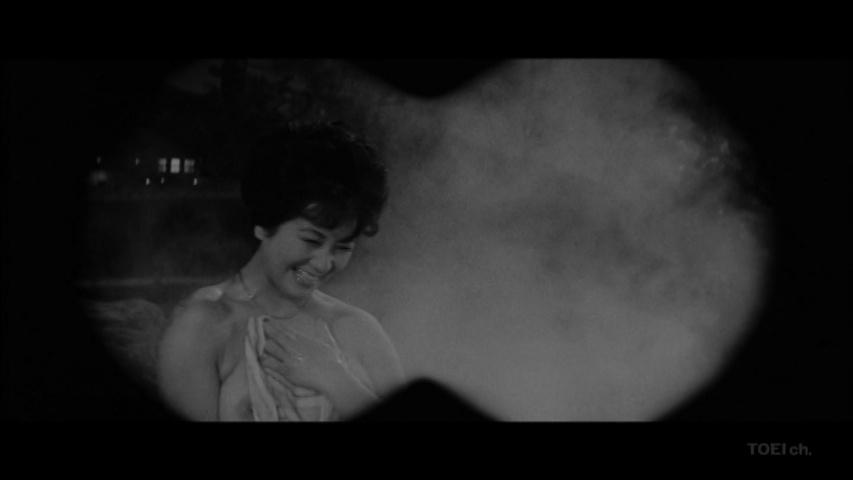





 Incoherent, yet fascinating youth docu-drama from Japan’s golden era of educational problems (*). The film opens with live recording of The Street Sliders performing their rock hit “Masturbation” (?!) and then proceeds cut back and forth between two separate storylines for the rest of the movie. The first one features a band-affiliated girl (Kazumi Kawai) exploring the ambivalent Tokyo in a strictly specified 24 hour timeframe in mid November. The other follows a transfer student (real life delinquent Namie Takada) being a bully bitch in different, loosely specified timeframe spanning about one year and partially overlapping with the 1st story.
Incoherent, yet fascinating youth docu-drama from Japan’s golden era of educational problems (*). The film opens with live recording of The Street Sliders performing their rock hit “Masturbation” (?!) and then proceeds cut back and forth between two separate storylines for the rest of the movie. The first one features a band-affiliated girl (Kazumi Kawai) exploring the ambivalent Tokyo in a strictly specified 24 hour timeframe in mid November. The other follows a transfer student (real life delinquent Namie Takada) being a bully bitch in different, loosely specified timeframe spanning about one year and partially overlapping with the 1st story. The post WWII Japan had experienced a period of respect towards educators as people saw education as a way out of poverty, but with the economic miracle and improved living conditions it seems some students seized to see teachers as invaluable. At the same time high school entrance rates were gradually going towards the roof (today it’s nearly 100%) as entrance became something that was expected of everyone. Soon every dumbass regardless of academic skill and suitability was going to high school. Unsurprisingly, problems would escalate especially in lower level private schools that accepted essentially any student whose parents were willing to pay tuition. There were students who were yankis or bosozoku biker gang members, and violence, bullying and even suicides ensued.
The post WWII Japan had experienced a period of respect towards educators as people saw education as a way out of poverty, but with the economic miracle and improved living conditions it seems some students seized to see teachers as invaluable. At the same time high school entrance rates were gradually going towards the roof (today it’s nearly 100%) as entrance became something that was expected of everyone. Soon every dumbass regardless of academic skill and suitability was going to high school. Unsurprisingly, problems would escalate especially in lower level private schools that accepted essentially any student whose parents were willing to pay tuition. There were students who were yankis or bosozoku biker gang members, and violence, bullying and even suicides ensued.
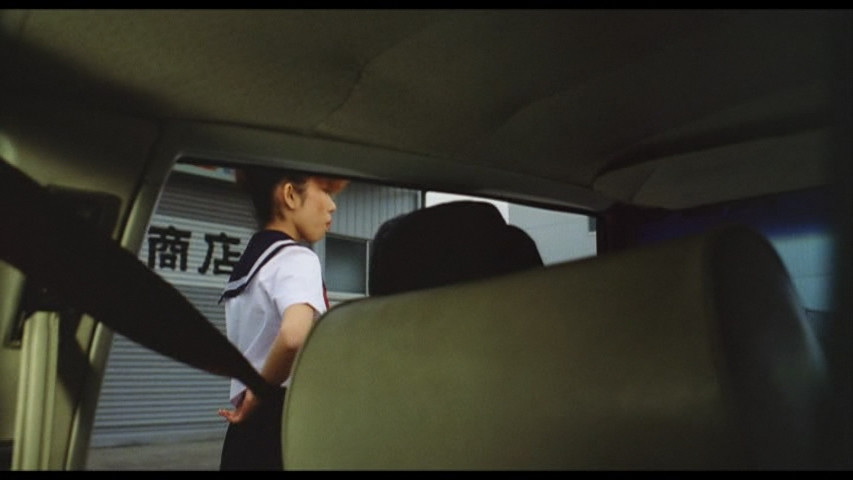
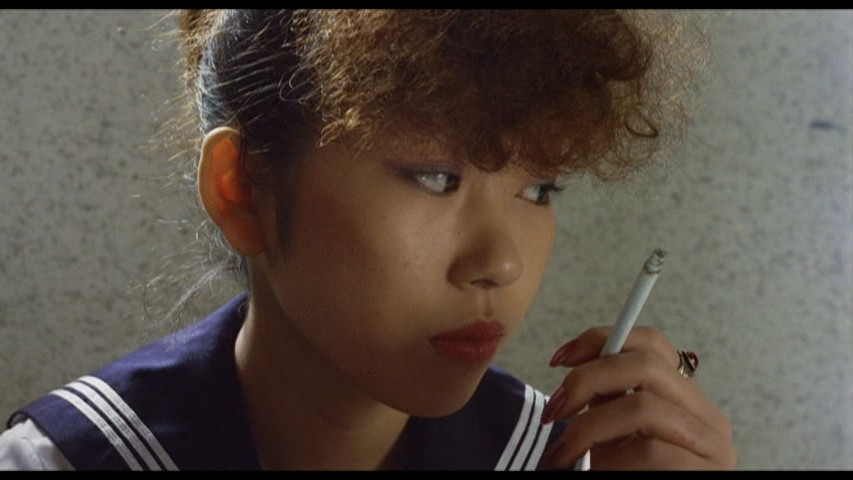
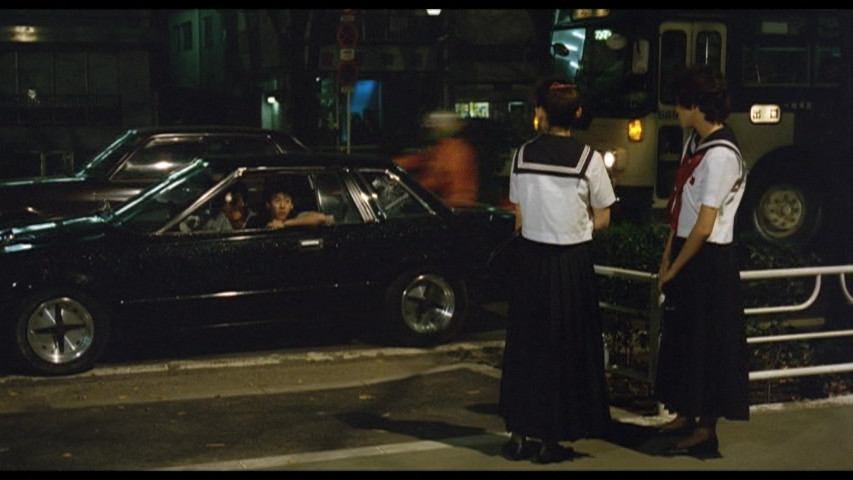


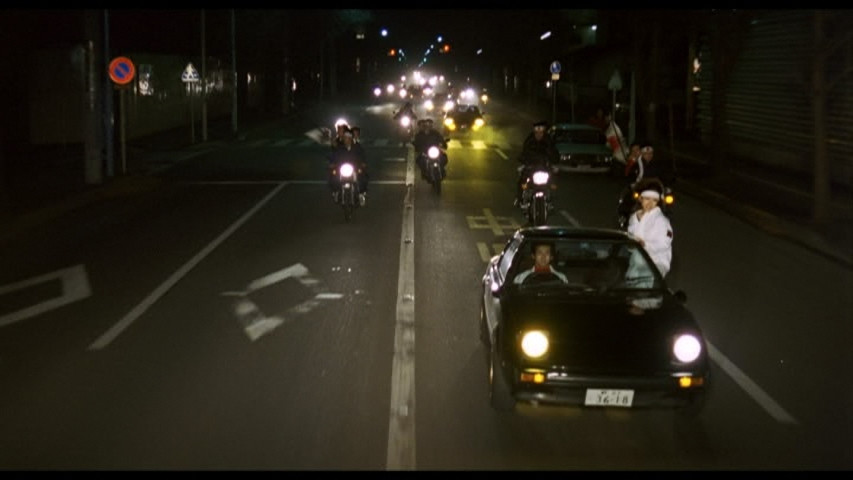
 Exciting delinquent girl drama is in equal parts a youth film and a blazing gangster movie set to “live” music à la Walter Hill’s Streets of Fire. First timer Yuko Watanabe stars as an Osaka bad girl who’s introduced to the world of indie rock bands by a friendly biker gay hanging out in a small a rock bar. The film was cast with open auditions, most of the sukeban girls being obvious real delinquents with wonderfully coarse Osaka dialects. The film is also packed with 80s heavy metal bands and rock stars with mindblowing names (Mad Rocker, Jesus, Christ etc.)
Exciting delinquent girl drama is in equal parts a youth film and a blazing gangster movie set to “live” music à la Walter Hill’s Streets of Fire. First timer Yuko Watanabe stars as an Osaka bad girl who’s introduced to the world of indie rock bands by a friendly biker gay hanging out in a small a rock bar. The film was cast with open auditions, most of the sukeban girls being obvious real delinquents with wonderfully coarse Osaka dialects. The film is also packed with 80s heavy metal bands and rock stars with mindblowing names (Mad Rocker, Jesus, Christ etc.)



 Nikkatsu Noir meets Girl Gang Films at Daiei. Michio Yasuda, one of the studio’s few female action stars, leads a group of three girls who make their living playing on the clubs. They soon run into trouble with the yakuza. The film has a phenomenally energetic opening with great music, fantastic cinematography and Yasuda kicking ass. It’s just a shame the storyline gradually takes a more conservative turn with emphasis shifted towards the male characters, who do the dirty work in the climax. It’s still a very stylish film with superb cinematography and amazing moments where director Akira Inoue sets scenes to a blazing rock score. The film also does great job capturing the streets and clubs populated by the lower class. This is a small discovery, although more noirish and down to earth than the likes of Stray Cat Rock that would make a passable comparison point.
Nikkatsu Noir meets Girl Gang Films at Daiei. Michio Yasuda, one of the studio’s few female action stars, leads a group of three girls who make their living playing on the clubs. They soon run into trouble with the yakuza. The film has a phenomenally energetic opening with great music, fantastic cinematography and Yasuda kicking ass. It’s just a shame the storyline gradually takes a more conservative turn with emphasis shifted towards the male characters, who do the dirty work in the climax. It’s still a very stylish film with superb cinematography and amazing moments where director Akira Inoue sets scenes to a blazing rock score. The film also does great job capturing the streets and clubs populated by the lower class. This is a small discovery, although more noirish and down to earth than the likes of Stray Cat Rock that would make a passable comparison point.





